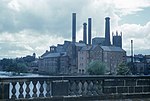Derby Cathedral
Anglican cathedrals in EnglandCarillonsChurch of England church buildings in DerbyshireChurches in DerbyDiocese of Derby ... and 7 more
English Gothic architecture in DerbyshireEngvarB from September 2013Grade I listed buildings in DerbyGrade I listed cathedralsJames Gibbs buildingsNeoclassical church buildings in EnglandTourist attractions in Derby

The Cathedral Church of All Saints, Derby, better known as Derby Cathedral, is a cathedral church in the city of Derby, England. In 1927, it was promoted from parish church status to that of a cathedral, creating a seat for the Bishop of Derby, which new see was created in that year. The original church of All Saints was founded in the mid-10th century as a royal collegiate church, dedicated to All Saints. The main body of the church as it stands today is a Georgian rebuilding by James Gibbs, completed in 1725. The tower dates from the 16th century, and a retroquire was added in the 20th century.
Excerpt from the Wikipedia article Derby Cathedral (License: CC BY-SA 3.0, Authors, Images).Derby Cathedral
Iron Gate, Derby Little Chester
Geographical coordinates (GPS) Address Website External links Nearby Places Show on map
Geographical coordinates (GPS)
| Latitude | Longitude |
|---|---|
| N 52.9248 ° | E -1.4773 ° |
Address
Derby Cathedral (All Saints)
Iron Gate
DE1 3GP Derby, Little Chester
England, United Kingdom
Open on Google Maps








